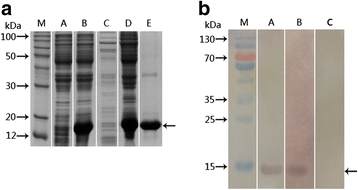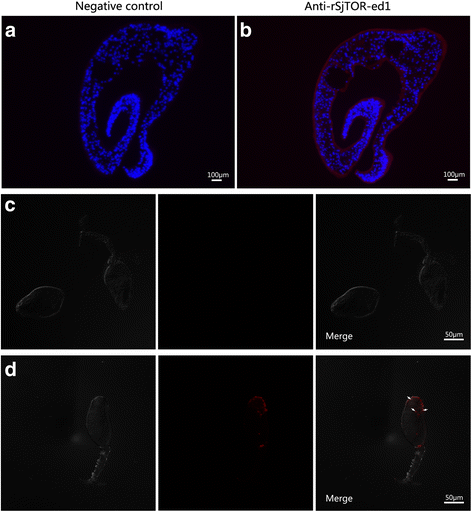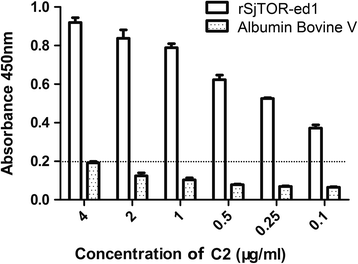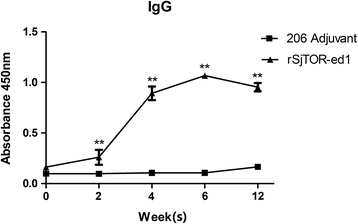Characterization of Schistosoma japonicum tetraspanning orphan receptor and its role in binding to complement C2 and immunoprotection against murine schistosomiasis
- PMID: 28599669
- PMCID: PMC5466742
- DOI: 10.1186/s13071-017-2229-y
Characterization of Schistosoma japonicum tetraspanning orphan receptor and its role in binding to complement C2 and immunoprotection against murine schistosomiasis
Abstract
Background: Schistosomiasis remains an important global public health problem, as millions of people are at risk of acquiring infection. An ideal method for sustainable control of schistosomiasis would be to develop an efficient vaccine. Schistosomes can survive in the host vascular system by immune evasion, regulating the host complement cascade. Schistosoma japonicum tetraspanning orphan receptor (SjTOR) is a complement regulator, which is a tegument membrane protein. To date there is no experimental evidence to explain the function of SjTOR.
Results: We cloned the first extracellular domain of the SjTOR (SjTOR-ed1) gene and expressed the gene in Escherichia coli. The expression level of SjTOR in different developmental stages of S. japonicum was assessed by quantitative real-time RT-PCR. Western blotting showed that recombinant SjTOR-ed1 (rSjTOR-ed1) could be recognised by schistosome-infected mouse serum. Immunolocalization indicated that the protein was mainly distributed on the tegument of the parasite. Haemolytic assays and ELISA revealed that rSjTOR-ed1 could inhibit complement hemolysis and bind to complement C2. Purified rSjTOR-ed1 emulsified with ISA206 adjuvant could induce a significant reduction of worm burden from 24.51 to 26.51%, and liver egg numbers from 32.92 to 39.62% in two independent trials in mice.
Conclusions: The results of this study indicated that rSjTOR-ed1 could inhibit complement hemolysis and bind to complement C2, and it is a potential vaccine candidate that protects against S. japonicum infection.
Keywords: C2-binding receptor; Schistosoma japonicum; Tetraspanning orphan receptor; Vaccine.
Figures








Similar articles
-
[Cloning, expression of gene SjOST48 from Schistosoma japonicum and evaluation of the immunoprotective efficacy of rSjOST48 in mice].Sheng Wu Gong Cheng Xue Bao. 2015 Apr;31(4):501-11. Sheng Wu Gong Cheng Xue Bao. 2015. PMID: 26380407 Chinese.
-
Characterization of VAMP2 in Schistosoma japonicum and the Evaluation of Protective Efficacy Induced by Recombinant SjVAMP2 in Mice.PLoS One. 2015 Dec 7;10(12):e0144584. doi: 10.1371/journal.pone.0144584. eCollection 2015. PLoS One. 2015. PMID: 26641090 Free PMC article.
-
Cloning, expression, and preliminary characterization of the dysferlin tegument protein in Schistosoma japonicum.Parasitol Int. 2013 Dec;62(6):522-9. doi: 10.1016/j.parint.2013.07.008. Epub 2013 Jul 25. Parasitol Int. 2013. PMID: 23892179
-
Schistosome transcriptomes: new insights into the parasite and schistosomiasis.Trends Mol Med. 2004 May;10(5):217-25. doi: 10.1016/j.molmed.2004.03.002. Trends Mol Med. 2004. PMID: 15121048 Review.
-
The Potential Role of Schistosome-Associated Factors as Therapeutic Modulators of the Immune System.Infect Immun. 2020 Jul 21;88(8):e00754-19. doi: 10.1128/IAI.00754-19. Print 2020 Jul 21. Infect Immun. 2020. PMID: 32341115 Free PMC article. Review.
Cited by
-
Complement Evasion: An Effective Strategy That Parasites Utilize to Survive in the Host.Front Microbiol. 2019 Mar 20;10:532. doi: 10.3389/fmicb.2019.00532. eCollection 2019. Front Microbiol. 2019. PMID: 30949145 Free PMC article. Review.
-
Immune Evasion Strategies of Schistosomes.Front Immunol. 2021 Feb 4;11:624178. doi: 10.3389/fimmu.2020.624178. eCollection 2020. Front Immunol. 2021. PMID: 33613562 Free PMC article. Review.
-
Schistosoma antigens: A future clinical magic bullet for autoimmune diseases?Parasite. 2024;31:68. doi: 10.1051/parasite/2024067. Epub 2024 Oct 31. Parasite. 2024. PMID: 39481080 Free PMC article. Review.
-
Effects of programmed cell death protein 10 on fecundity in Schistosoma japonicum.Parasitol Res. 2020 Apr;119(4):1317-1325. doi: 10.1007/s00436-020-06635-1. Epub 2020 Mar 9. Parasitol Res. 2020. PMID: 32152713
-
An Excretory Protein of Echinococcus multilocularis Inhibits Complement Classical Pathway Activation.Infect Drug Resist. 2022 Feb 22;15:555-568. doi: 10.2147/IDR.S344075. eCollection 2022. Infect Drug Resist. 2022. PMID: 35228806 Free PMC article.
References
-
- WHO Expert Committee Prevention and control of schistosomiasis and soil-transmitted helminthiasis. World Health Organ Tech Rep Ser. 2002;912:i-vi–1-57. - PubMed
-
- Lei ZL, Zhang LJ, Xu ZM, Dang H, Xu J, Lv S, et al. Endemic status of schistosomiasis in People's Republic of China in 2014. Zhongguo Xue Xi Chong Bing Fang Zhi Za Zhi. 2015;27(6):563–569. - PubMed
MeSH terms
Substances
LinkOut - more resources
Full Text Sources
Other Literature Sources
Miscellaneous

